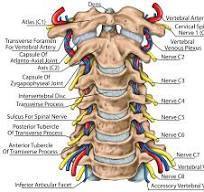
It seems to me that roughly half the patients I treat or people I talk to about chiropractic all agree on one thing: the neck adjustment freaks them out! I’ve been asked if adjusting the neck will cause them to be paralyzed, if it will kill them, or as mild as will it hurt. Its few and far between.
When I get people in the door who have had chiropractic care for a long time, they don’t even think twice about it. They know that they have neck pain, and getting it adjusted makes the pain go away. Even a dog can pick up on that logic. So why do so many first timers get freaked out by the neck adjustment?
I’ll answer that question as honestly as possible, but first I want to double down on why the neck adjustment is important. So, if you don’t care for some background information, just skip the next 3-4 paragraphs. I’ll never know it anyway!
In the neck, aka cervical spine, there are 7 vertebrae. 2 are atypical, and the remaining 5 are typical. The first 2 vertebrae, named the Atlas and Axis , are so vastly different from the remaining 5 typical, that once you see them it will become obvious why they have their own names. These 7 bones are all stacked upon each other and create a C-shaped curve, called lordosis. On top of C1 is the skull, where the spinal cord makes its appearance and travels all the way down the center of the spine before ending around L1, where it continues on as a big bundle of nerves. Between each level of the spine are branches of nerves that emerge from the sides of the spine and travel to muscles and organs in the body. Lastly, there are little holes in every cervical vertebrae, except for C7, along the sides that house the vertebral artery. This artery continues up the brain stem and supplies blood to very important structures in the skull, called the brain and brainstem.
So here we are with roughly an 8 lb skull that rests on top of C1 and the remaining bones of the cervical spine. In a perfectly aligned spine, the skull is balanced on top of the cervical lordosis with muscles and passive ligaments acting as guy wires. But all of this changes when you spend any sort of time looking down at your phone or laptop. As you flex your head forward, you lose the lordosis in the C spine and the 8 lb skull is now causing 60+ lbs of force on the neck. To keep your head from lopping forward, the upper traps and other major muscles must contract, and the loss of lordosis puts a lot more stress on the lower portion of the C spine, specifically C5-C7. These levels of the spine statistically are most likely to turn into DDD and DJD later in life if this posture continues for weeks, months, and years.
Before we get to the moment we’ve all been waiting for, one or two more things to consider.. All the nerves that travel down the shoulders and arms to the hands and fingers all leave the lower cervical spine. It’s a TON of nerves that are responsible for fine motor skills like buttoning a button or writing with a pen. Put a bulging disc, bone spur, or inflammation in contact with any of these nerves, you get that annoying numbness or tingling down the arm.
This is where the adjustment comes in. Adjusting in the specific area of the spine that’s causing issues will keep C5-7 mobile so DDD/DJD is less likely to occur, and it can keep those nerves from getting compressed or irritated by a disc or bony protrusion. The neck adjustment will keep your neck feeling normal and fix/prevent those annoying aches and pains that can bring you to your knees when its bad enough.
If you skipped the boring biomechanics stuff, hello again! So the first reason I think people are freaked out by the neck adjustment are the movies.. specifically Arnold Schwarzenegger. I grew up watching his movies and guess how he likes to kill the bad guys? You guessed it, snapping their neck. Its quick and easy and silent, which is ideal for anyone who’s trying to be sneaky. I don’t blame his movie characters, I would do the same thing. But dang its given chiropractors a bad rap. The way I adjust a neck is oddly similar to how Arnold takes out the bad guy. So that’s the first reason why I think people are freaked out by neck adjustments, because many of us grew up watching heroes subdue the bad guy in a very similar way.
Trust is another big reason. Let’s say it’s your first time seeing a chiropractor at my office, and it’s also our first time meeting. There’s not a ton of trust established yet, and you’re trusting me enough to take your neck and quickly whip it this way or that way. Even though I feel extremely comfortable manipulating a neck, the fact that I’m a stranger to you who you just met is a hard issue to overcome. I should at least buy you dinner first, right? I think trust is a major reason, or at least it is for me when I get my neck adjusted by someone new.
I saved the best and biggest reason for last, I’m glad you stuck with me so far. Just last week on Instagram, a friend forwarded a post to me about a girl who died after getting her neck adjusted by a chiropractor. That’s all the information in the post, and that’s all that’s really needed to make people freak the F*@k out! I can 100% understand that mindset. Chiropractors are apparently out there killing folks Arnold Schwarzenegger style.
So why do people sometimes die, have a stroke, or become paralyzed after a neck adjustment? Let me start off by saying that this is extremely rare, but also common enough that we talked about it out the whazoo in chiropractic school (1 in a million to be exact). The first and most common reason are the vascular structures in the neck. Carotid and vertebral arteries are usually to blame. I have good news though! If you’re a perfectly healthy person who doesn’t have underlying vascular issues or risk factors like hypertension, high cholesterol, or a history of stroke, there’s practically 0 risk. That’s also assuming the chiropractor is competent and isn’t being super aggressive and rough with your neck. If you have a history of weak vasculature or have plaque built up in the artery, it’s easy enough to imagine that an adjustment could further damage the weakened artery wall or break off some plaque that can then travel to the brain. Either scenario would potentially decrease blood supply to the brain and result in a stroke.
The last reason I’ll discuss here involves the transverse ligament of C2. This ligament is largely responsible for keeping your C1 and skull from translating forwarding and pinching your spinal cord when flexing your head/neck forward. There are a few reasons why someone wouldn’t have a transverse ligament or have a weakened one, and its somewhat common. Down syndrome, rheumatoid arthritis, EDS, and other rare congenital abnormalities are the most common causes. In this scenario, adjusting the upper cervicals in an aggressive manner would surely increase the chances of causing permanent damage to the spinal cord, potentially resulting in becoming paralyzed. But again, that’s extremely rare and any decent chiropractor would be aware of this beforehand.
Regarding the transverse ligament and vascular issues, there are simple ways to rule out any of these red flags. The first is taking an in-depth history of medical conditions and discussing these things with your chiropractor. A well-trained chiro will identify these red flags and take caution before whipping your neck around. Combine the health history with basic vitals like BP and HR, and a handful of tests for the vertebral and carotid artery, can rule in/out a lot of risks of the neck adjustment.
In conclusion, it’s up to the patient to discuss any personal health history that may put them at risk, and it’s up to the chiro to identify any red flags that may make adjusting the neck dangerous. No chiropractor wants to hurt their patient, they got into the field to make them better! When I hear of a chiropractor hurting a patient, I feel empathy for both the patient and the doctor. There have been a handful of times that I’ve refused to adjust a person’s neck, but usually I’m game. While I don’t know the specifics in these cases I see in the news, I usually assume there was an underlying vascular issue. I will continue to adjust my patients necks who need it and who feel comfortable with me manipulating them. But I also have no ill will to those who don’t want me to adjust their neck. Your body, your choice at OHP.
Brian Trautman
Contact Me


